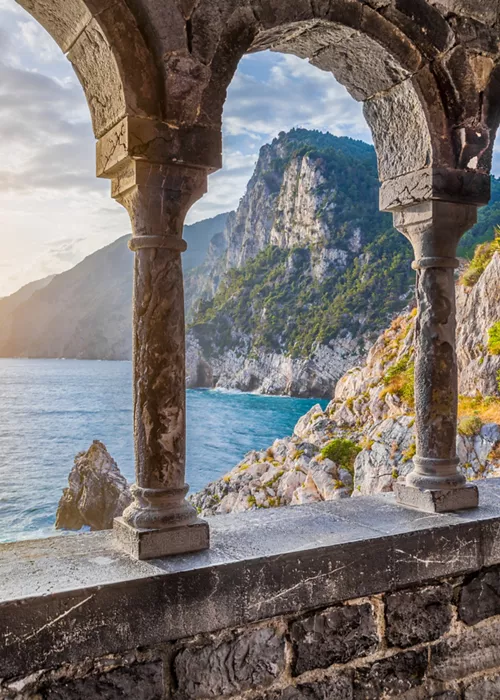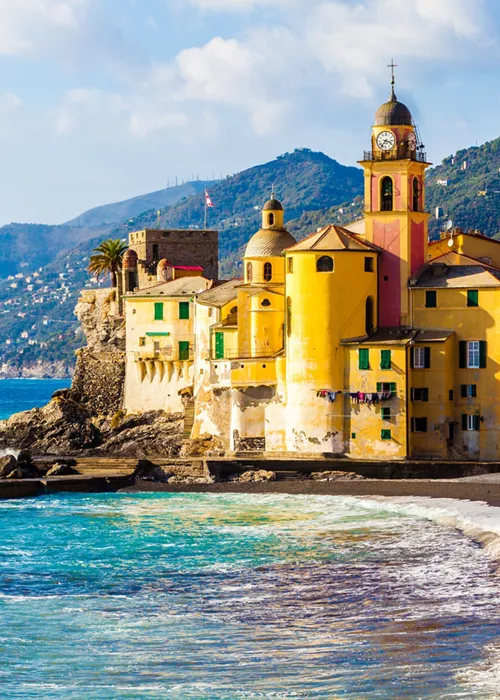3 lesser-known villages near the Cinque Terre in Eastern Liguria
9 minutes

Index
When tourists travel to the Riviera di Levante in Eastern Liguria, they often stick to the world-famous destinations of Portofino and the Cinque Terre, but let me tell you that this region has so much more to offer. Sure, those are very picturesque villages you should visit at least once in your life. But did you know that close by, the Golfo dei Poeti (Gulf of Poets) is also home to some similarly stunning colourful villages facing the Mediterranean sea? You might know Portovenere, which is often considered the sixth village of the Cinque Terre, but on the other side of the gulf, Lerici, Ameglia, and their authentic hamlets are full of surprises too. Even better, the Gulf of the Poets is the perfect destination for a holiday without a car!
Portovenere

In the far west of the Gulf of Poets lies the colourful harbour of Portovenere, facing a small archipelago that hides a lush regional park (Parco Naturale Regionale di Porto Venere). The whole area is classified as a UNESCO World Heritage Site together with the Cinque Terre. No need to say that you have to visit Portovenere if you are in the area: this old fishermen's village is as beautiful and unique as the Cinque Terre, with the advantage of having more beaches, restaurants and accommodation options.
Via Capellini is the main street of the village: this is where you will find most shops. The narrow streets of the medieval centre of Portovenere will lead you to the Doria Castle. From there, you will get the best views of the village, with the wonderful Church of San Pietro perched atop a rocky promontory, some quaint old mills and the archipelago of Palmaria in the background. The fortifications of Portovenere, that go up to the castle, are also quite impressive and well-preserved. The village was fortified in the 12th century by the Republic of Genoa to protect itself from the Republic of Pisa. This is a must-see in Portovenere, so check the opening times of the castle before going.
Byron's Cave, a 20-metre-deep natural cave facing the sea, is another cool spot of Portovenere. You will find it in the lower part of the village, on the way to the Church of San Pietro. This cave, which is nowadays a popular swimming spot, is said to have been the inspiration for one of Lord Byron's poems.
If the weather is good, don't miss a boat tour to the archipelago of Palmaria, Tino and Tinetto. There are tourist boats offerings 1-hour guided tours around the islands, as well as regular shuttle boats that will drop you in different parts of Palmaria. Once there, you can hike in the regional park that covers the island with luxurious vegetation or enjoy its beaches. Pozzale Beach on Palmaria is considered one of the best beaches in Liguria and is easily accessible with shuttle boats. All boats leave from the Portovenere harbour, and you can buy your tickets on the spot. In Palmaria, the only inhabited island of Liguria, you will also find military fortifications, sea caves as well as impressive cliffs up to 188 meters high. The two other islands of the archipelago are smaller: Tino island has some more military fortifications as well as the ruins of an old monastery, and in Tinetto (the smallest), there’s not much to see except some birds and a statue of the Virgin Mary that marks a dangerous spot for boats.
During my trip to Portovenere, I stayed in Le Grazie, a hamlet of Portovenere that is less touristy, less expensive and much calmer. I highly recommend you stop there if you have some time. Le Grazie is known for its Roman villa of Varignano, which has a small archaeological museum.
Top 5 things not to miss
- The panoramic views from the Doria Castle
- A boat tour of the Palmaria Archipelago
- The Church of San Pietro, the oldest church in the Gulf
- Swim at Byron's Cave
- Try the local food: Anciùa is a good option for quality street food.
Portovenere: Useful Information
Best time to visit: in the summer (from June to September), Portovenere is packed, but you have regular boats to Portovenere from La Spezia and the Cinque Terre, which is, for me, the best way to get there. Visiting Portovenere off-season still has great advantages, as you will get much cheaper accommodation prices and will find a more local atmosphere as most international tourists are gone.
How to get there: from Spring to Autumn, Navigazione Golfo dei Poeti runs boats linking the Cinque Terre, Levanto and La Spezia with Portovenere. If you are on a short trip, you can take a day pass and hop off at as many stops as you want during the day. The least expensive way to visit Portovenere is to take the bus from La Spezia, which has a train station with good connections to Genoa, Firenze and Milano. In La Spezia, you can also still find some free car park options. There are no free car parks in Portovenere, except if you book accommodation with one.
Lerici

On the other side of the Gulf of the Poets is Lerici, a historic seaside resort with a series of lesser-known hamlets. Lerici is known to have been frequented by many writers and poets over the centuries (such as Lord Byron, Mary Shelley, and before them Dante, Petrarca and Boccaccio), who all found their inspiration in the beautiful landscapes of the gulf.
The centre of Lerici is dominated by an old castle facing the sea, built in the 12th century as a means of defence during the wars between the Republic of Pisa and the Republic of Genoa. Inside you will find a beautiful Chapel dedicated to Saint Anastasia, but the main attraction of the castle is the view over the Gulf of Poets. The good thing is that you don't even need to climb up there, as there is a free elevator from the Lerici harbour leading you to the entrance of the castle. Piazza Garibaldi, the main square of Lerici, is in the lower part of the village. You will find a lot of good seafood restaurants around it.
A visit to the Lerici hamlets is a must if you are in the area. West of Lerici is San Terenzo, which has its own little castle facing the castle of Lerici on the other side of the bay (the only interest in visiting this castle is the view). You can walk there from Lerici following a nice seaside walkway. Between those two parts of Lerici, you will find popular and easily accessible beaches, including the Blue Flag Venere Azzurra Beach. I stayed in San Terenzo and enjoyed the quieter atmosphere of the hamlet, which still has some very good options to eat.
East of Lerici are Fiascherino and Tellaro, two smaller villages, with around them some smaller and wilder beaches. Tellaro was my favourite hamlet: this fishermen's village looked like the Cinque Terre with its little harbour and the colourful houses perched above it, except that there were almost no tourists! The hamlet of Tellaro is classified as one of the Borghi Più Belli d'Italia (Most Beautiful Villages of Italy) and is also part of the Regional Natural Park of Montemarcello-Magra. Some of the most beautiful hikes of the park pass through Tellaro. Climbing up above the village, you can for instance easily reach the two abandoned historic hamlets of Portesone and Barbazzano, offering panoramic views of the Gulf of Poets.
Top 5 things not to miss
- The castles of Lerici and San Terenzo for panoramic views of the Gulf of the Poets
- The colourful hamlet of Tellaro and its little harbour
- The beaches of Lerici
- Renting an e-bike to tour the hamlets of Lerici
- Try the local food: Lerici has amazing fish restaurants.
Lerici: Useful Information
Best time to visit: Lerici will be very busy in the summer as Italian families love its beaches. Spring and Autumn are good to enjoy the villages and the trails with good temperatures and no crowds.
How to get there: the easiest way to visit Lerici and its hamlets is to take a bus from La Spezia train station. I don't recommend driving to Lerici: car parks are a nightmare (plus they are very expensive) and buses are so easy and cheap that it really is the best option. In high season, there are also regular boat connections to Lerici from Portovenere and the Cinque
Ameglia

At the extreme east of the Gulf of Poet, close to the border with Tuscany, you will find Ameglia and its hamlets surrounded by some of the most beautiful landscapes of the region known as the Val di Magra, with the sea and the river Magra on one side, and the mountains on the other side (you can even see the Apuani Alps in the background).
The village of Ameglia is a medieval hilltop village which has expanded in the lower part of the hill into a modern village. But at the top, the oldest part of the village is still intact and even pedestrian. After passing through the main gate to the medieval village, you feel like you went back in time. The village is incredibly quiet: I literally only came across some cats, one of which gave me a private tour of the Ameglia castle, dating back from the 13th century (with a defence tower from the 10th century). At the time of my visit, only the small gardens of the castle could be visited.
Excavations have proved that the Ameglia area has been inhabited since the Iron Age. A large Preroman Necropolis from the 4th century BC has been found in the Cafaggio hamlet. It was used by the Apuani tribe, one of the Ligurian tribes who were settled around the Magra river. It should soon be part of an archaeological museum also encompassing another archaeological site found in the area, the Roman villa of Bocca di Magra at the mouth of the river.
Perched on the Caprione promontory 226 meters above sea level, the hamlet of Montemarcello is another part of Ameglia that is worth a visit. This colourful and picturesque village is classified as one of the Borgi più Belli d'Italia (Most beautiful villages in Italy). From Via della Chiesa, you access the village through a large stone entrance. The visit to the village is quick, but its colourful alleyways are typically Ligurian. The village also has a cute church dedicated to Saint Peter and a circular tower from the 12th century.
Top 5 things not to miss
- The medieval pedestrian centre of Ameglia, with its panoramic views
- The quaint hamlet of Montemarcello and the cute cafe on its main square
- The trails of the Regional Natural Park of Montemarcello-Magra, especially the area of the Caprione promontory between Ameglia and Lerici.
- The wild creeks of Punta Bianca and Punta Corvo (quite the hike down but worth it)
- Bocca di Magra and the shores of the Magra River (river excursions are also organized in the summer)
Ameglia: Useful Information
Best time to visit: the villages and trails of the Ameglia area are great to visit all year around. As they are not as touristic as the neighbouring villages, they will be calmer in the summer too. Ameglia has a small Festival dedicated to the figs of Montemarcello (Sagra del Fico) every September.
How to get there: there is an excellent network of buses in the region, which I recommend you use as driving and parking in this area is not always easy. The easiest way to reach Ameglia and its hamlets is to take a train to La Spezia and then the bus.
Article written about the experience of Emmanuelle Hubert - Au goût d'Emma.




















